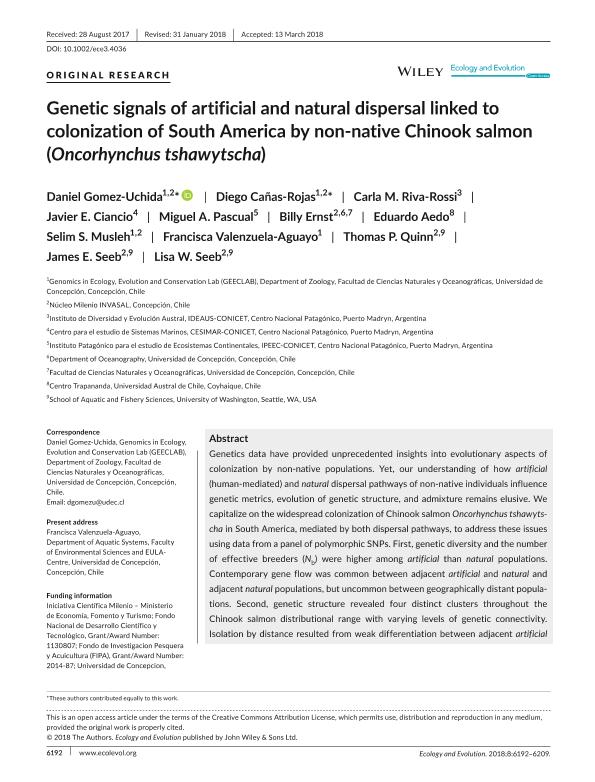Mostrar el registro sencillo del ítem
dc.contributor.author
Gomez Uchida, Daniel
dc.contributor.author
Cañas Rojas, Diego
dc.contributor.author
Riva Rossi, Carla Marcela

dc.contributor.author
Ciancio Blanc, Javier Ernesto

dc.contributor.author
Pascual, Miguel Alberto

dc.contributor.author
Ernst, Billy
dc.contributor.author
Aedo, Eduardo
dc.contributor.author
Musleh, Selim S.
dc.contributor.author
Valenzuela Aguayo, Francisca
dc.contributor.author
Quinn, Thomas P.
dc.contributor.author
Seeb, James E.
dc.contributor.author
Seeb, Lisa W.
dc.date.available
2019-11-14T17:54:55Z
dc.date.issued
2018-06
dc.identifier.citation
Gomez Uchida, Daniel; Cañas Rojas, Diego; Riva Rossi, Carla Marcela; Ciancio Blanc, Javier Ernesto; Pascual, Miguel Alberto; et al.; Genetic signals of artificial and natural dispersal linked to colonization of South America by non-native Chinook salmon (Oncorhynchus tshawytscha); John Wiley & Sons Ltd; Ecology and Evolution; 8; 12; 6-2018; 6192-6209
dc.identifier.uri
http://hdl.handle.net/11336/88894
dc.description.abstract
Genetics data have provided unprecedented insights into evolutionary aspects of colonization by non-native populations. Yet, our understanding of how artificial (human-mediated) and natural dispersal pathways of non-native individuals influence genetic metrics, evolution of genetic structure, and admixture remains elusive. We capitalize on the widespread colonization of Chinook salmon Oncorhynchus tshawytscha in South America, mediated by both dispersal pathways, to address these issues using data from a panel of polymorphic SNPs. First, genetic diversity and the number of effective breeders (Nb) were higher among artificial than natural populations. Contemporary gene flow was common between adjacent artificial and natural and adjacent natural populations, but uncommon between geographically distant populations. Second, genetic structure revealed four distinct clusters throughout the Chinook salmon distributional range with varying levels of genetic connectivity. Isolation by distance resulted from weak differentiation between adjacent artificial and natural and between natural populations, with strong differentiation between distant Pacific Ocean and Atlantic Ocean populations, which experienced strong genetic drift. Third, genetic mixture analyses revealed the presence of at least six donor geographic regions from North America, some of which likely hybridized as a result of multiple introductions. Relative propagule pressure or the proportion of Chinook salmon propagules introduced from various geographic regions according to government records significantly influenced genetic mixtures for two of three artificial populations. Our findings support a model of colonization in which high-diversity artificial populations established first; some of these populations exhibited significant admixture resulting from propagule pressure. Low-diversity natural populations were likely subsequently founded from a reduced number of individuals.
dc.format
application/pdf
dc.language.iso
eng
dc.publisher
John Wiley & Sons Ltd

dc.rights
info:eu-repo/semantics/openAccess
dc.rights.uri
https://creativecommons.org/licenses/by-nc-sa/2.5/ar/
dc.subject
ARGENTINA
dc.subject
CHILE
dc.subject
GENETIC STOCK IDENTIFICATION
dc.subject
INDIVIDUAL ASSIGNMENT
dc.subject
INVASION GENETICS
dc.subject
PACIFIC SALMON
dc.subject.classification
Biología

dc.subject.classification
Ciencias Biológicas

dc.subject.classification
CIENCIAS NATURALES Y EXACTAS

dc.title
Genetic signals of artificial and natural dispersal linked to colonization of South America by non-native Chinook salmon (Oncorhynchus tshawytscha)
dc.type
info:eu-repo/semantics/article
dc.type
info:ar-repo/semantics/artículo
dc.type
info:eu-repo/semantics/publishedVersion
dc.date.updated
2019-10-23T21:15:04Z
dc.identifier.eissn
2045-7758
dc.journal.volume
8
dc.journal.number
12
dc.journal.pagination
6192-6209
dc.journal.pais
Reino Unido

dc.conicet.avisoEditorial
All articles accepted from 14 August 2012 are published under the terms of the Creative Commons Attribution License. All articles accepted before this date, were published under a Creative Commons Attribution Non-Commercial License.
dc.description.fil
Fil: Gomez Uchida, Daniel. Núcleo Milenio Invasal; Chile. Universidad de Concepción; Chile
dc.description.fil
Fil: Cañas Rojas, Diego. Núcleo Milenio Invasal; Chile. Universidad de Concepción; Chile
dc.description.fil
Fil: Riva Rossi, Carla Marcela. Consejo Nacional de Investigaciones Científicas y Técnicas. Centro Científico Tecnológico Conicet - Centro Nacional Patagónico. Instituto de Diversidad y Evolución Austral; Argentina
dc.description.fil
Fil: Ciancio Blanc, Javier Ernesto. Consejo Nacional de Investigaciones Científicas y Técnicas. Centro Científico Tecnológico Conicet - Centro Nacional Patagónico. Centro para el Estudio de Sistemas Marinos; Argentina
dc.description.fil
Fil: Pascual, Miguel Alberto. Consejo Nacional de Investigaciones Científicas y Técnicas. Centro Científico Tecnológico Conicet - Centro Nacional Patagónico. Instituto Patagónico para el Estudio de los Ecosistemas Continentales; Argentina
dc.description.fil
Fil: Ernst, Billy. Universidad de Concepción; Chile. Núcleo Milenio Invasal; Chile
dc.description.fil
Fil: Aedo, Eduardo. Universidad Austral de Chile; Chile
dc.description.fil
Fil: Musleh, Selim S.. Universidad de Concepción; Chile. Núcleo Milenio Invasal; Chile
dc.description.fil
Fil: Valenzuela Aguayo, Francisca. Universidad de Concepción; Chile
dc.description.fil
Fil: Quinn, Thomas P.. Núcleo Milenio Invasal; Chile. University of Washington; Estados Unidos
dc.description.fil
Fil: Seeb, James E.. Núcleo Milenio Invasal; Chile. University of Washington; Estados Unidos
dc.description.fil
Fil: Seeb, Lisa W.. Núcleo Milenio Invasal; Chile. University of Washington; Estados Unidos
dc.journal.title
Ecology and Evolution
dc.relation.alternativeid
info:eu-repo/semantics/altIdentifier/doi/http://dx.doi.org/10.1002/ece3.4036
dc.relation.alternativeid
info:eu-repo/semantics/altIdentifier/url/https://onlinelibrary.wiley.com/doi/full/10.1002/ece3.4036
Archivos asociados
